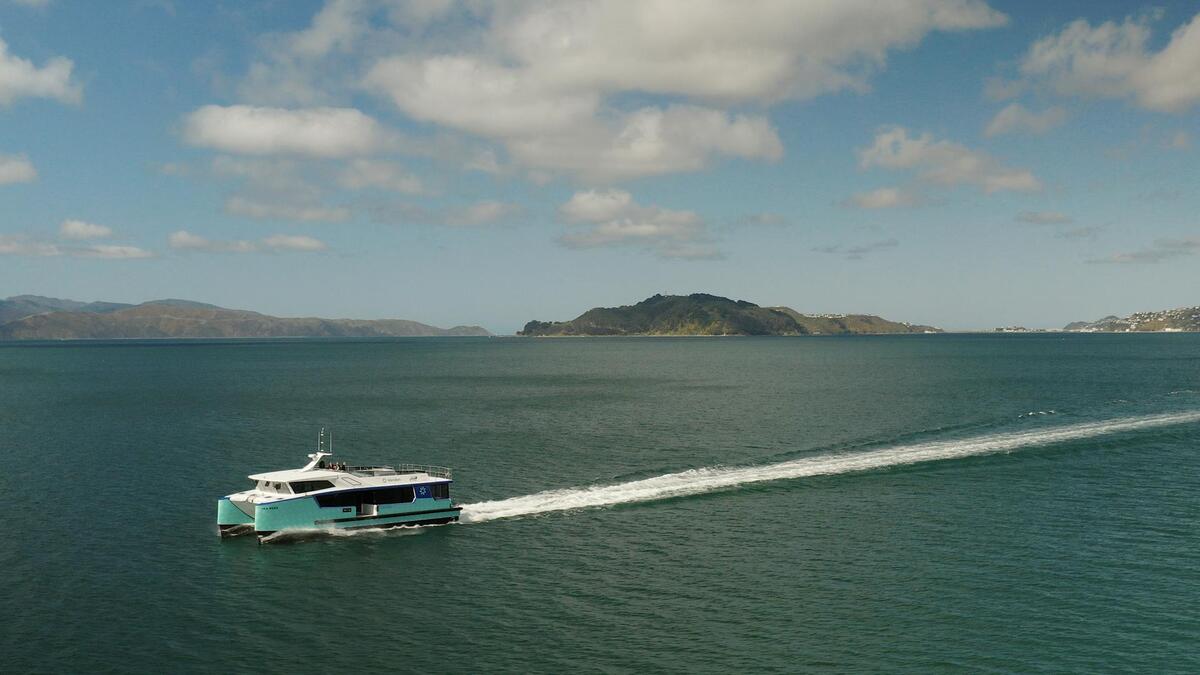Shipyard WEBBCo says second electric ferry’s increased onboard energy storage would save ferry operator East by West Ferries $280,000 NZD (US$180,000) per year
Just months after East by West Ferries launched the southern hemisphere’s first fully electric, high-speed passenger ferry in Wellington, New Zealand, the Kiwi ferry operator is expediting an order for its second all-electric vessel.
WEBBCo, the shipyard that built the battery-powered, 19-m, 135-passenger ferry Ika Rere (meaning flying fish in the Maori language) that came into service in Wellington at the end of March 2021, said the fast-tracked order for the second electric ferry was based, in part, on the savings East by West Ferries has seen since its first vessel launched.
“As fuel costs rise to staggering levels globally, East By West is reaping the benefits of the 132 pax electric vessel, with incremental route energy costs being slashed by 82%: a return trip to Days Bay on Ika Rere costs just $28 NZD in electricity, slightly higher than one Adult passenger fare. This equates to cost savings of $180,000 NZD per year when compared to their diesel boats doing the same journey,” WEBBCo said.
By adding another electric vessel with greater onboard energy storage to its fleet, WEBBCo projects that East by West Ferries will be able to save a further $280,000 NZD per year in overall energy costs.
Adding a second ferry would also allow East By West Ferries to run its entire existing schedule using the two fully-electric ferries.
“Following an in-depth business case, and with the success of Ika Rere, we’ve made the decision to push for funding for a second fully-electric ferry to be built by WEBBCo. We always knew we wanted to expand our electric-powered route capabilities, and with global interest in New Zealand’s electric boatbuilding, we wanted to secure a build slot for the second vessel. Ika Rere is performing exceptionally well, and we had no hesitation about continuing with our partners,” East By West Ferries Managing Director Jeremy Ward said.
Ika Rere was designed and built to complete one return run of 25 km, with an approximate run time of 30 minutes in each direction, before charging dockside at a rate of 1-MW per 15 minutes while passengers disembark and board. The ferry will be charged from a 300-kW charger at its overnight berth during its first year of operation.
The company’s second electric vessel will be a sister ship to Ika Rere, and run on the existing route between Queens Wharf, /Somes Island, and Days Bay. It will carry 132 passengers; however, it will be equipped with a newer iteration of battery technology, enhancing onboard energy storage. Both vessels will be charged at Queens Wharf, with the potential to expand charging infrastructure to use the newly released Megawatt Charging Standard (MCS), which is also being considered within the project.
The New Zealand Government anticipates each ferry will help shave 640 tonnes of carbon emissions annually compared with a similar-sized diesel alternative. The vessels also have a higher top speed than their diesel equivalents, as their pairs of 325-kW engines are built to push the vessels to 22 knots, compared with diesel engines which move similar vessels at about 14 knots at full capacity.
Research by the New Zealand Government has found that domestic ships such as ferries and freighters emit close to 300,000 tonnes of CO2 every year. In Wellington, nearly 50% of the city’s emissions were produced from the transport sector in 2020 and the city’s council is seeking alternative energy forms of transport as it looks to decarbonise.
Danfoss’ Editron drivetrain systems power the ferry. The system consists of two propulsion motors, two grid systems for the AC network and six DC/DC converters connected to the vessel’s batteries. All these components operate via a DC cabinet and are controlled via an electronic control system.






